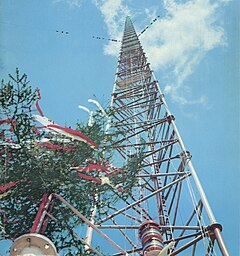Warsaw radio mast
| Warsaw Radio Mast | |
|---|---|
| Radiofoniczny Ośrodek Nadawczy w Konstantynowie |
|

Mast prior to topping out
|
|
| General information | |
| Status | Collapsed |
| Type | Mast radiator insulated against ground |
| Location | Konstantynów, Gąbin, Poland |
| Coordinates | 52°22′3.74″N 19°48′8.73″E / 52.3677056°N 19.8024250°ECoordinates: 52°22′3.74″N 19°48′8.73″E / 52.3677056°N 19.8024250°E |
| Construction started | July 1970 |
| Completed | 18 May 1974 |
| Destroyed | 8 August 1991 |
| Height | 646.38 m (2,120.67 ft) |
| Design and construction | |
| Architect | Jan Polak at Mostostal M-1 Zabrze (radio mast) |
| Civil engineer | Andrzej Szepczyński at Mostostal M-4 Zabrze |
| Other designers |
Alimak of Sweden (elevator) |
| Main contractor | Polish Broadcasting Company |
Alimak of Sweden (elevator)
Brown & Boveri of Switzerland (transmitters)
The Warsaw Radio Mast was the world's tallest structure from 1974 until its collapse on 8 August 1991. It is the second tallest structure ever built, being surpassed as tallest by the Burj Khalifa, completed in 2010.
The mast, which was designed by Jan Polak, was 646.38 metres (2,120.7 ft) tall. Its construction, started in July 1970, was completed on 18 May 1974, and its transmitter entered regular service on 22 July of that year. It was located in Konstantynów, Gąbin, Poland, and was used by Warsaw Radio-Television (Centrum Radiowo-Telewizyjne) for longwave radio broadcasting on a frequency of AM-LW (long wave) 227 kHz before 1 February 1988 and AM-LW (long wave) 225 kHz afterwards. Its base was 115.2 metres (378 ft) above sea level. Because a voltage potential of 120 kV existed between the mast and ground, it stood on a 2 metres (6.6 feet)-high insulator. It operated as a mast radiator (half-wave radiator), so its height was chosen in order to function as a half-wavelength antenna at its broadcasting frequency. The signals from its 2 megawatt transmitters could be received across essentially the entire globe. Its weight was debated: Polish sources claimed 420 tonnes (930,000 lb).
The Warsaw radio mast was a guyed steel lattice mast of equilateral triangular cross section, with a face width of 4.8 metres (16 ft). The vertical steel tubes forming the vertices of the mast had a diameter of 245 millimetres (10 in); the thickness of the walls of these tubes varied between 8 and 34 mm (0.31 to 1.33 in) depending on height. The mast consisted of 86 elements, each of which had a length of 7.5 metres (25 ft). The mast had 3 arrays of guy wires, each attached to the mast at 5 levels: 121.78 metres (399.5 ft), 256.78 metres (842.5 ft), 369.28 metres (1,211.5 ft), 481.78 metres (1,580.6 ft), and 594.28 metres (1,949.7 ft) above ground.] Each guy was fixed on a separate anchor block at the ground and was 50 millimetres (2.0 in)) in diameter. To prevent the guy wires from interfering with the radio transmissions, the guys were insulated at regular intervals. The weight of guys and insulators used to anchor the mast was 80 metric tons (180,000 lb). An elevator and separate protected ladders were installed in the interior of the mast to facilitate access to the various mast components, including the aircraft warning lamps. The elevator had a maximum speed of 0.35 metres per second (1.1 ft/s) and required 30 minutes for a trip from the bottom of the structure to the top.
...
Wikipedia
